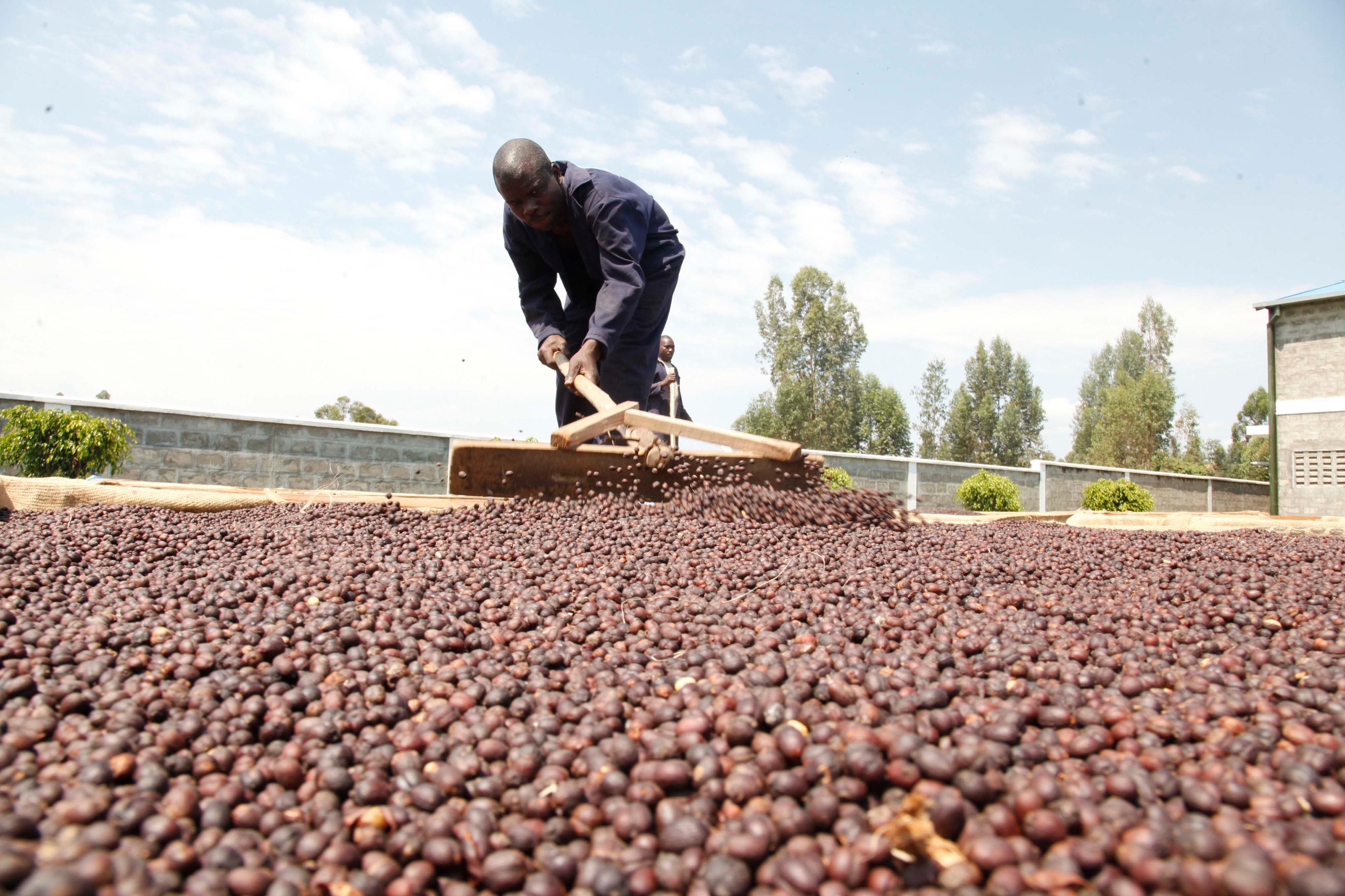How value addition will raise farmers’ productivity, income

A farmer dries coffee beans on the ground. Many farmers fail to access local and international markets for their products, mainly due to poor post-harvest practices and using poor storage facilities. This also implies need for value addition. PHOTO/RACHEL MABALA
What you need to know:
Under the Network of Producers and Exporters Uganda Ltd, a traceability system is created to monitor farmers to improve on the storage such that the aflatoxin is controlled between the aggregator and the farmer.
In countries like Uganda that produce most agricultural commodities in surplus, national markets are not sufficient to drive economies of scale and incentivise farmers to invest in productivity and quality improvement.
Many farmers fail to access local and international markets for their products, mainly due to poor and traditional post-harvesting practices and using poor storage facilities.
Recently, Kenya implemented a ban on importation of maize from Uganda citing high levels of aflatoxins which make it unfit for human consumption.
Aflatoxins are one of the dangerous food toxins that start as a mould on a cereal due to high moisture content, which is normally attributed to poor drying methods of cereals.
Drying maize should not be done on bare ground, rather a tarpaulin should be used or other materials to dry the cereals.
Sun-drying maize on the ground exposes it to moisture absorption. While sun-drying is the most common method of drying maize grain, it should be replaced with maize shelling under a shelter to prevent physical damage of the grain.
Large scale and commercial farmers should invest in mechanised harvesting using machines such as combined harvesters.
Other constraints hindering the commercialisation of agriculture by smallholder farmers and general development of the agricultural value chains include low levels of value addition, poor seed quality, low produce and lack of market access.
Farmers should form groups and cooperatives through which they can be trained, offered financial assistance and be linked to different markets for their products.
Under the Regional East Africa Community Trade in Staples Project-II (REACTS-II), farmer cooperatives in different parts of Uganda have been trained and equipped with modern skills in post-harvesting handling, value addition as well as connecting them to different regional markets.
Mr Patrick Muganga REACTS-II project manager, says the three-year project implemented in Uganda, Kenya and Rwanda is targeting different value chains.
In Uganda, it has been supporting maize and beans value chains to enable farmers and dealers to unlock the opportunities.
“SMEs especially cooperatives are a critical link between farmers and market off takers and this project was set up to build capacity of SMEs to take advantage of national and regional trade in staples,” Mr Muganga says.

Mr Junior Ikara receives a customer’s maize at a milling plant in Aloet, Bukedea district. There is limited access to adequate and quality volumes of maize PHOTO/Eronie Kamukama
Uganda exports at least 90 per cent of its maize to Kenya with a cumulative average of 330,620 tonnes, according to data from Bank of Uganda. Between January 2020 and January 2021, Uganda’s maize exports stood at 351,420 tonnes with a monthly average of 50,203 tonnes.
Under the REACTS-II project, more than 15,000 metric tonnes of produce has been exported to regional markets, especially Kenya.
In 2019, REACTS-II organised a visit for some aggregators to expose them to more structured maize market opportunities in Kenya.
But more than 10,000 small scale millers in Kenya are faced with limited access to adequate and quality volumes of maize in a timely manner, with more favourable engagement terms.
Mr Muganga says the Ugandan aggregators were introduced to the Agro-processors Association of Kenya, a platform that brings together 67 small scale maize millers. The two parties agreed to handle trade-related problems, including loss of money by Kenyan millers to Ugandan brokers through fraudulent deals, poor quality produce and high costs of business transactions, considering that they must camp in Uganda to get required volumes.
Another outcome of the exposure visit was the need for Ugandan traders and cooperatives to meet the required volumes. This led to the formation of the Network of Producers and Exporters Uganda Ltd (NePEU).
NePEU is an association of cooperatives that came together to tap into both local and regional markets, especially for grains such as maize, beans and soybeans.
According to the chairman of NePEU, Godfrey Mayambala, the platform is for establishing accountability and traceability among members.
“Through cooperatives, we help local farmers access regional markets. The network links these cooperatives to different buyers across the region,” he says.
Under NePEU, a traceability system is created to monitor farmers to ensure that they improve on the storage, handling system such that the aflatoxin is controlled between the aggregator and the farmer.
How the platform works
Mr Mayambala says traders in Uganda post information on available produce (maize, beans) on the common platform and solicit for markets from Kenyan buyers.
Interested parties have side negotiations and once an agreement is reached, the importers make payment for the consignment through Agro-processors Association of Kenya (APAK) or deposit directly to supplier’s account after consulting APAK and NePEU secretariat. The supplier is given two to four days to prepare the consignment upon receipt of payment.




